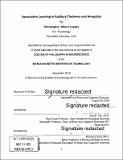Associative learning in auditory thalamus and amygdala
Author(s)
Leppla, Christopher Albert.
Download1292981362-MIT.pdf (11.55Mb)
Other Contributors
Massachusetts Institute of Technology. Department of Brain and Cognitive Sciences.
Advisor
Kay M Tye.
Terms of use
Metadata
Show full item recordAbstract
Although much pioneering work has furthered our understanding of the roles the medial geniculate nucleus of the thalamus (MGN) and basolateral amygdala (BLA) play in the formation of associative learning, many open questions remain. MGN is often thought of as only contributing relayed sensory information, and BLA the primary site of importance for the formation of associative learning, aspects of these assumptions have not been directly tested. It is known that both regions are necessary for learning to occur, but the current empirical understanding of the role MGN plays is lacking. Here we present circuit-specific characterization of the information MGN transmits to BLA during discriminative learning, using a combination of optogenetics and in vivo single unit electrophysiology. We demonstrate that while MGN may act as a relay station for information necessary for learning, this is an active process. This input also exhibits dynamic changes between conditions which can also be seen in the BLA population it projects onto. This provides strong evidence suggesting it plays an active role in learning, rather than the assumed role, restricted to sensory relay. Finally, we show that BLA encodes unavoidable punishment associations more strongly than avoidable punishment associations through a shift in the bias of difference encoding of these associations. Taken together, these findings suggest that the assumption of a sensory relay role for MGN in the formation of association central to current dogma is incomplete, and that the avoidability of an associated punishing outcome impacts the magnitude with which BLA encodes the bias between reward and punishment-associated tones.
Description
Thesis: Ph. D. in Neuroscience, Massachusetts Institute of Technology, Department of Brain and Cognitive Sciences, September, 2019 Manuscript. Includes bibliographical references.
Date issued
2019Department
Massachusetts Institute of Technology. Department of Brain and Cognitive SciencesPublisher
Massachusetts Institute of Technology
Keywords
Brain and Cognitive Sciences.